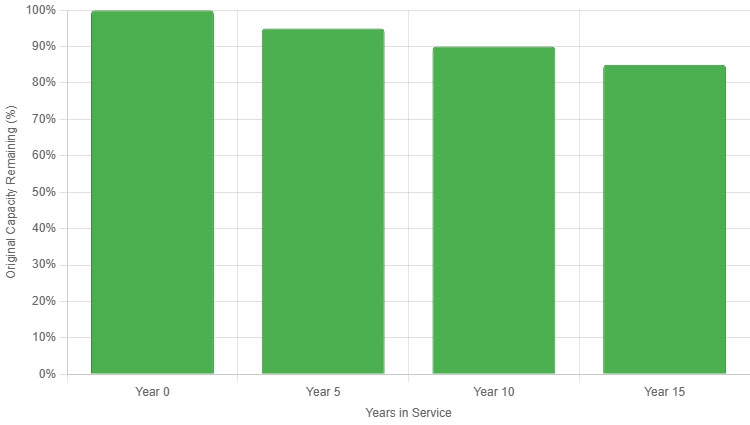Got an old solar panel collecting dust in your garage? Maybe it’s from an old RV setup or a home system you upgraded years ago. Before you toss it or buy a new one, you might wonder: Can I still use it? Reusing old solar panels can save you hundreds of dollars and reduce electronic waste. In this guide, we’ll walk you through a 3-step evaluation process to determine if your old panels are worth reusing, and show how pairing them with a high-quality LiFePO4 battery can create an efficient, budget-friendly system.
Why Consider Reusing Old Solar Panels?
Old solar panels often come from early home systems, RV camping kits, or abandoned projects. Reusing them has clear benefits:
- Save Money: A new 100W panel costs $100-$200, while an old one is free.
- Go Green: Extending panel life reduces electronic waste, supporting sustainable energy goals.
- Versatile Uses: Perfect for small projects like campsite lighting or garden pumps.
But there are challenges to watch out for:
- Efficiency Loss: Panels degrade by about 0.5%-1% per year, so a 10-year-old panel might deliver only 80-90% of its original power.
- Maintenance Costs: Old panels may need frequent checks or repairs, like replacing corroded junction boxes.
- System Complexity: Matching old panels with modern components, like LiFePO4 batteries, can complicate system design.
These challenges can trip you up, but we’ll cover how to avoid them in the “3 pitfalls” section below.
3-Step Evaluation: Are Your Old Solar Panels Still Usable?
Follow these three practical steps to quickly determine if your old panels are worth reusing. They’re simple enough for DIY beginners and can save you valuable time and money.
Step 1: Inspect the Physical Condition
Start with a thorough visual check:
- Cracks or Scratches: Even tiny cracks in the glass can worsen over time due to temperature changes or stress, leading to reduced output or failure. Use a magnifying glass to spot micro-cracks.
- Junction Box Issues: Look for corrosion, burn marks, or loose connections, which can cause power loss or safety hazards.
- Frame Damage: Check for bent or rusted frames, which affect mounting stability.
Pro Tip: Significant cracks or corrosion often mean the panel isn’t worth reusing. Small scratches are usually okay but monitor them for expansion.
Step 2: Test the Output Performance
Next, measure how much power your panel can still produce:
- Use a multimeter to measure open-circuit voltage (Voc) and short-circuit current (Isc) under direct sunlight, ideally around noon. Ensure the panel faces the sun at the correct angle (roughly 30-45° depending on your location).
- Calculate power: Power (W) = Voc × Isc × 0.8 (the 0.8 is an experience factor accounting for real-world losses).
- Example: A 10-year-old 100W panel might show Voc = 18V, Isc = 5A, giving 18 × 5 × 0.8 = 72W, a 28% loss.
Safety Warning: Never touch the panel’s electrical contacts during testing. Disconnect the panel and wear insulated gloves to avoid shocks.

If your panel’s output is low, it might still work for small needs. Regular testing ensures it performs reliably.
Step 3: Confirm Compatibility with Modern Systems
Old panels (often 12V or 24V) must work with your system’s components, especially LiFePO4 batteries:
- Voltage Match: Ensure the panel’s voltage aligns with your battery (e.g., 12V or 24V LiFePO4 batteries).
- Current Compatibility: The panel’s current must suit your charge controller. A MPPT controller optimizes low-output panels, as explained in the U.S. Department of Energy’s photovoltaic design guide.
- Avoid the Bucket Effect: Mixing old and new panels in a series reduces the system’s output to the weakest panel’s level, as the least efficient panel sets the current for the whole string.
An MPPT controller maximizes your old panel’s potential, especially with a LiFePO4 battery.
Pairing with LiFePO4 Batteries: Reviving Old Panels
Old panels often have lower output, but a LiFePO4 battery can make them shine. Here’s why LiFePO4 batteries are ideal:
- Efficient Charging: They handle low-current inputs, perfect for older panels.
- Long Lifespan: 10-15 years of cycle life, outlasting lead-acid batteries.
- Built-in Safety: Docan Power’s LiFePO4 batteries include a BMS to protect against overcharging, over-discharging, and short circuits.
Example Setup: Pair an 80W old panel with a 100Ah 12V LiFePO4 battery and a 20A MPPT controller. The panel produces ~6.7A (80W ÷ 12V). In theory, it takes ~15-20 hours to charge from 50% depth of discharge, but weather, temperature, or shading may extend this.
For tips on keeping your battery in top shape, read our guide on maintaining LiFePO4 batteries.
Best Uses for Old Solar Panels
Old panels are perfect for small projects:
- Camping: Power LED lights or charge phones.
- Shed or Garage: Pair with a 50Ah LiFePO4 battery for lighting.
- DIY/Educational Projects: Use in school experiments or community workshops to teach solar energy.
- Emergency Backup: Combine with a LiFePO4 battery for outages.
3 Pitfalls to Avoid When Reusing Old Panels
Don’t let these mistakes derail your project:
- Ignoring Efficiency Loss: A panel that’s lost 30% power won’t meet high-demand needs. Test regularly.
- Mixing Old and New Panels: The bucket effect tanks system output. Use old panels in a separate string. See our guide on avoiding battery and PV system mistakes for more details.
- Skipping Safety: Faulty wiring or missing BMS can damage your LiFePO4 battery. Use a battery with built-in BMS for safety.
Conclusion: Old Panels + LiFePO4 = Budget-Friendly Power
Reusing old solar panels is a smart way to save money and go green. By checking their condition, testing output, and ensuring compatibility, you can use them for camping, DIY projects, or emergency power. Pairing them with a Docan Power LiFePO4 battery maximizes efficiency and reliability. Ready to start? Dust off that old panel, grab a multimeter, and explore LiFePO4 battery solutions!
FAQs
How long can old solar panels last?
Depending on degradation, 5-10 more years for low-demand uses.
What’s the risk of mixing old and new panels?
The bucket effect reduces output to the weakest panel’s level.
How should I store old solar panels?
Keep them in a dry, ventilated place, avoiding stacking or pressure to prevent damage.
Are old panels suitable for high-load systems?
No, their lower output makes them better for low-power needs like lighting or charging.

-1060x400w.webp)


Leave a Comment